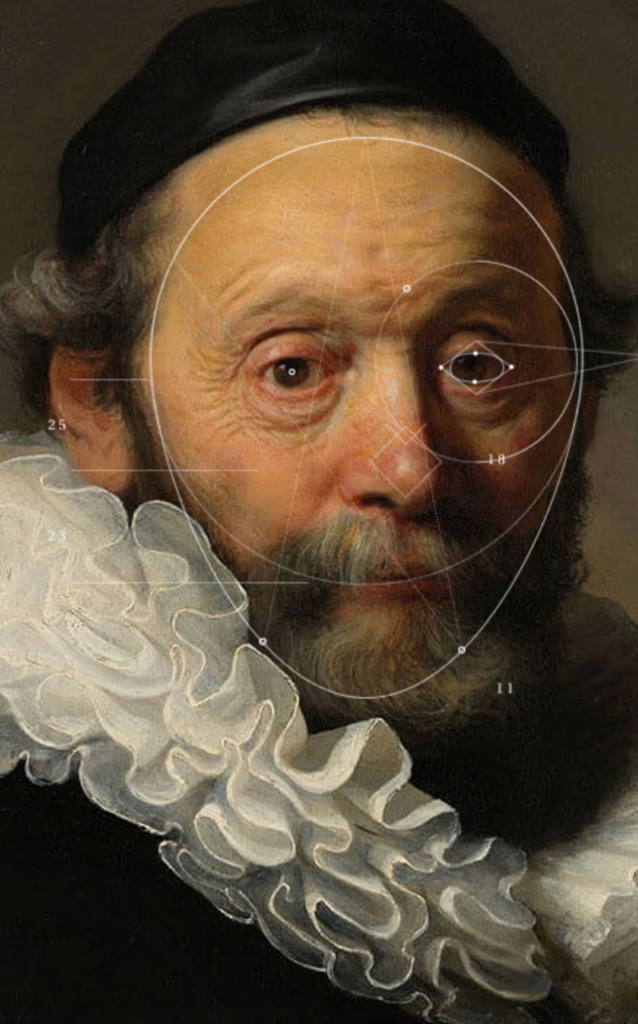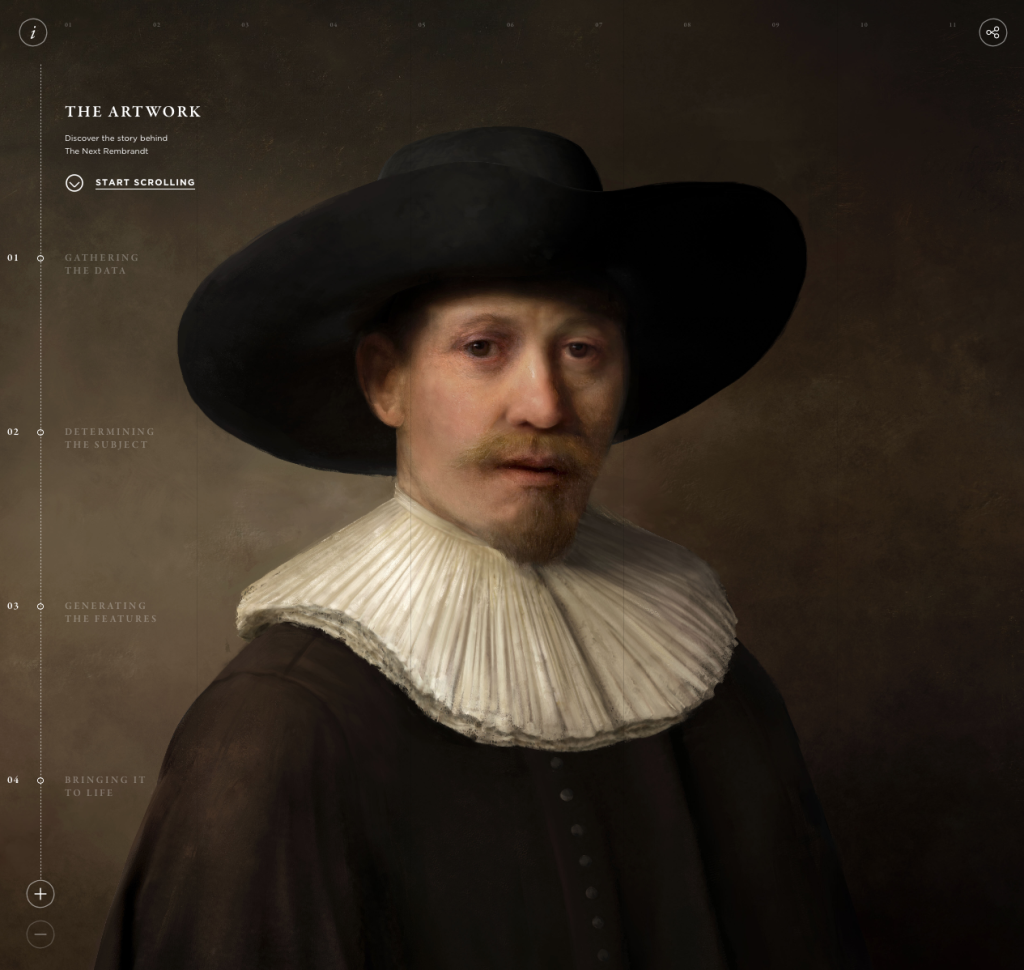The technical world of 3D printing is an absolute wonder of precision and possibility. It has become clear that there is an as yet unlimited potential for improvement of the human condition through disaster relief solutions, medical interventions, and tools to satisfy scientific curiosity. The question that then arises is this: is there space in this data driven technology for connection with the human spirit?
An effort to address just this question has come from what might seem like an unlikely place: the advertising agency J Walter Thompson on behalf of the Dutch financial institution ING. Delve a bit deeper into the corporate identity of ING, though, and you find, in addition to its typically enlightened Dutch workplace sensibility, a deep commitment to the arts. This particular arts project developed through a collaboration among ING, Microsoft, TU Delft, Mauritshuis, and Rembrandthuis and centered on combining contemporary data gathering and production technologies, art connoisseurship, and the sensibility of the greatest Dutch painter to have ever lived.
More than just an effort to document or reproduce a work of art, something that has already been demonstrated as well within the realm of 3D technologies capabilities, the effort in this project, titled The Next Rembrandt, was to see if that information could then be reconverted back into something human, in this case an entirely new painting. The idea was that with sufficient data gathered, it might be possible to continue Rembrandt’s work despite the fact that he died nearly 400 years ago.
 The first step in the project was to understand the basic building blocks of a Rembrandt, to “distill the artistic DNA” necessary to produce something that didn’t just appear ‘like’ a Rembrandt on the surface, but that was built as a Rembrandt from the ground up. To that end, 346 paintings by the great master were carefully analyzed and 150 gigabytes of digitally rendered graphics were collected.
The first step in the project was to understand the basic building blocks of a Rembrandt, to “distill the artistic DNA” necessary to produce something that didn’t just appear ‘like’ a Rembrandt on the surface, but that was built as a Rembrandt from the ground up. To that end, 346 paintings by the great master were carefully analyzed and 150 gigabytes of digitally rendered graphics were collected.
In studying Rembrandt’s body of work, it becomes clear that the portrait is one of the primary loci of his artistic power. His oeuvre contains more male faces than female, with a preference for those looking to the right, sharply lighted, wearing dark clothing, a white ruffled collar, and a hat. After determining that these would be parameters for the piece to be created, an in-depth study of the proportions and features of the faces in his works was undertaken. In an explanation of the process, the team stated:
“To master his style, we designed a software system that could understand Rembrandt based on his use of geometry, composition, and painting materials. A facial recognition algorithm identified and classified the most typical geometric patterns used by Rembrandt to pain human features. It then used the learned principles to replicate the style and generate new facial features for our painting.”
The piece itself was then 3D printed using a machine that works with paint-based UV inks. A painting is, after all, only nominally two-dimensional. Part of what differentiates it from a print is the brush work and the layered buildup of material. While the topography of a painting may not be as dramatic as a sculpture, it is an integral part of the works presence. Joris Dik, of the Technical University at Delft, described the process of preparing for the 3D printing of a new Rembrandt:
“We looked at a number of Rembrandt paintings, and we scanned their surface texture, their elemental composition, and what kinds of pigments were used. That’s the kind of information you need if you want to generate a painting by Rembrandt virtually.”
 A height map was created for the new painting based on information gathered from existing pieces and followed by the printer as it placed 13 layers of ink to mimic the painterly presence of Rembrandt himself. And when the print was completed, Ron Augustus, Director of SMB Markets at Microsoft, reflected:
A height map was created for the new painting based on information gathered from existing pieces and followed by the printer as it placed 13 layers of ink to mimic the painterly presence of Rembrandt himself. And when the print was completed, Ron Augustus, Director of SMB Markets at Microsoft, reflected:
“We are using a lot of data to improve business life, but we haven’t been using data that much in a way that touches the human soul. You could say that we are using technology and data like Rembrandt used his paints and his brushes to create something new.”
So is Rembrandt creating anew? No, most certainly not. While the painting is a fascinating project and a very well executed study in artistic production, we shouldn’t get carried away. We do the project an injustice, and a further to Rembrandt, however, if the only question is: “Is this a new Rembrandt?” Indeed a painting is more than just a summation of past work, it includes accidents of process and the inner vision of the artist, something that is specific to each piece, not simply an average of them all.
 The creation of an algorithm that can generate a universal ‘Rembrandt-esque’ face removes the essential power of the specificity of his individualized portrayals. And art historians miss the point when they criticize the application of light or the sharpness of the paint. It’s not that you wouldn’t expect those things in an original Rembrandt, but that this is decidedly not an original Rembrandt. And the very idea that one Rembrandt created 400 years after another would demonstrate nothing more than a continued replication of past work is as far removed from a compliment as this new piece is from something produced by the artist’s own hand.
The creation of an algorithm that can generate a universal ‘Rembrandt-esque’ face removes the essential power of the specificity of his individualized portrayals. And art historians miss the point when they criticize the application of light or the sharpness of the paint. It’s not that you wouldn’t expect those things in an original Rembrandt, but that this is decidedly not an original Rembrandt. And the very idea that one Rembrandt created 400 years after another would demonstrate nothing more than a continued replication of past work is as far removed from a compliment as this new piece is from something produced by the artist’s own hand.
Does this work touch the human soul? Not quite, but it is reaching towards it. Is this work a new Rembrandt? No, but it is very much the next Rembrandt. What do you think? Discuss in the 3D Printed Rembrandt forum over at 3DPB.com.
Subscribe to Our Email Newsletter
Stay up-to-date on all the latest news from the 3D printing industry and receive information and offers from third party vendors.
Print Services
Upload your 3D Models and get them printed quickly and efficiently.
You May Also Like
From Saddles to Sculptures: Hermès’ Equestrian Legacy Meets 3D Printing
A horse in the park, birds in flight, and a window that tells a story with curves and colors. This is the latest visual tale from Hermès, unveiled at Amsterdam’s...
Adidas Launches 3D Printed Climacool Slip-On Globally Today
Today, May 2, 2025, marks the official global release of the Adidas Climacool, a fully 3D printed sneaker designed for breathability, comfort, and performance. After a limited early drop on...
3DPOD 246: 3D Printing at Oechsler, with Andreas Knoechel
Andreas Knoechel, Head of Program Management for Additive Manufacturing at Oechsler, is doing some real heavy lifting in production. German plastics manufacturer Oechsler was the pioneer behind 3D-printed shoes at...
Communicating Vessels: Four 3D Printing Markets
Of late, I’ve been considering the 3D printing market not as a single, unified industry but as four distinct markets, each with its own needs. Rather than segmenting the market...

































